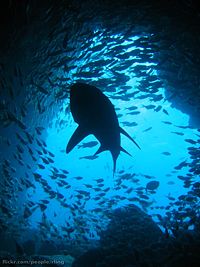Animal
| Animals | ||||||
|---|---|---|---|---|---|---|
 "This grey nurse shark (Carcharias taurus) and the smaller fish surrounding it are animals."
| ||||||
| Scientific classification | ||||||
| ||||||
| Phyla | ||||||
|
Infrakingdom Eumetazoa
|
The animals are the group of organisms classified in the kingdom Animalia. They are all multicellular eukaryotes, and also ingest their food and move by their own power at some point in their life cycle.[1]
Etymology
The word animal comes from the Latin animale, which is derived from anima, meaning "vital breath".
Characteristics
Cells and tissues
Animals are eukaryotic, meaning that they are comprised of cells which contain a nucleus. Unlike plants and fungi, their cells lack cell walls. Unlike bacteria, archaea and most protists, they are also usually multicellular.[1]
Animal cells are organized into specialized, integrated structures called tissues, which may in turn be organized into organs. Common to all animals is epithelium, a protective tissue covering their surfaces.[1] Many animals also share other structures such as guts (chambers with one or more openings for digestion), muscles (organs which contract for locomotion), and nerves (tissues which transmit signals between cells).
In addition, animals may be grouped by the number of tissue layers their embryos have. Sponges have but one, while diploblasts have two and triploblasts have three. In diploblasts and triploblasts, the inner layer is called the endoderm (which develops into the gut and associated tissue) and the outer layer is called the ectoderm (which develops into skin and the nervous system). Triploblasts also have a layer in between called the mesoderm, which develops into many internal organs such as the circulatory system, muscle, and bone.[1]
Food and energy
Animals are heterotrophs: they obtain nutrients by ingesting food from outside, generally digesting food in an internal chamber. This separates them from plants, algae, and other autotrophs, which do not ingest food. They are consumers that often occupy the higher levels of food chains in many ecosystems.[1] They obtain their food in a dazzling array of methods: for instance, rancher ants tend aphids and harvest the sugar that they secrete.[2]
Methods of obtaining food
Animals typically obtain food in two ways. Predation is a biological interaction where a heterotroph, called the predator, obtains food by consuming the cells of another organism, called the prey. Herbivores are predators that primarily consume autotrophs, carnivores are predators that primarily consume heterotrophs, and omnivores are predators that consume both autotrophs and heterotrophs.
The other major method of obtaining food is detritivory, where a heterotroph consumes food from detritus: dead organic matter. Detritivores recycle nutrients and are thus important in decomposition.
Methods of feeding
The methods of feeding that animals use may be grouped into four general tactics. Suspension feeding, or filter feeding, filters out and concentrates food particles suspended in water or air, such as a baleen whale filtering out plankton. Deposit feeding swallows a substrate and ingests the microorganisms, detritus, and other cells within the substrate, such as an earthworm eats through soil. Fluid feeding sucks fluids such as body fluids from plants and animals, such as a butterfly drinking a flower's nectar. Mass feeding, or bulk feeding, eats chunks of flesh from prey into the mouth, such as a snail eating pieces of leaves. [1]
Body plan
Symmetry and cephalization
Animals, like other multicellular organisms, can be classified on their symmetry: are they symmetrical on zero, one, two, or more planes? The sponges are completely asymmetrical, but every other animal is symmetrical in at least one plane. Organisms symmetrical on more than two planes are radially symmetrical; they appear like the spokes of a bicycle wheel, and most alive today float in water or attach to substrates. Organisms with only one plane are bilaterally symmetrical; they have left and right sides and two ends, and they tend to possess longer and narrower bodies.[1]
Bilateral symmetry in animals also exhibit cephalization: the development a head on one end where feeding, sensory, and processing organs are concentrated. Bilateral symmetry and cephalization are both pervasive in animals, and it is thought that they enabled animals to more actively move and hunt.
Movement
Animals are motile during at least one point of their life cycle. They move by a large variety of methods: swimming, crawling on a substrate, walking, or flying.[1]
Reproduction and life cycle
Origin and phylogeny
Molecular phylogeny has shown that a group of protists called the choanoflagellates are the closest living relatives to animals, and that the sponges are the closest, most basal phylum in the animals to them.